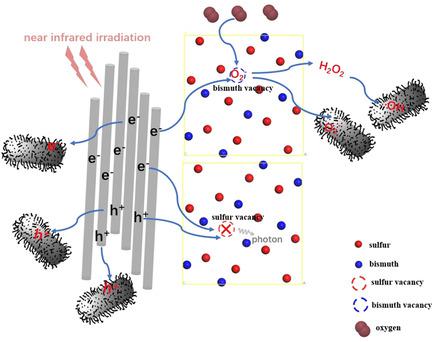当前位置:
X-MOL 学术
›
ChemSusChem
›
论文详情
Our official English website, www.x-mol.net, welcomes your
feedback! (Note: you will need to create a separate account there.)
Defect‐Type‐Dependent Near‐Infrared‐Driven Photocatalytic Bacterial Inactivation by Defective Bi2S3 nanorods
ChemSusChem ( IF 7.5 ) Pub Date : 2019-01-22 , DOI: 10.1002/cssc.201802440 Hongli Sun 1 , Zhifeng Jiang 1 , Dan Wu 2 , Liqun Ye 3 , Tianqi Wang 1 , Bo Wang 1 , Taicheng An 4 , Po Keung Wong 1, 4
ChemSusChem ( IF 7.5 ) Pub Date : 2019-01-22 , DOI: 10.1002/cssc.201802440 Hongli Sun 1 , Zhifeng Jiang 1 , Dan Wu 2 , Liqun Ye 3 , Tianqi Wang 1 , Bo Wang 1 , Taicheng An 4 , Po Keung Wong 1, 4
Affiliation

|
Defect engineering is crucial in tailoring photocatalytic efficiency, but it suffers from uncertainty in determining the vacancy type and in which type of the vacancy can better promote the photocatalytic efficiency. In this study, Bi2S3 nanorods with bismuth or sulfur vacancies were synthesized to investigate their distinct effects on the electronic structure, electron–hole separation characteristics, and near‐infrared (NIR)‐driven photocatalytic bacterial inactivation activity. Both bismuth and sulfur vacancies can enhance the light absorption ability of Bi2S3. However, the lifetime of photoinduced electrons is extended by bismuth vacancies but shortened by sulfur vacancies. Owing to these tendencies, Bi2S3 with Bi vacancies fully inactivated 7 log E. coli cells within 40 min of NIR irradiation, displaying better NIR‐driven photocatalytic bacterial inactivation efficiency than Bi2S3 with S vacancies. This study discloses the defect‐type‐dependent photocatalytic behaviors, providing new insights into designing highly efficient photocatalysts.
中文翻译:

Bi2S3纳米棒的缺陷类型依赖于近红外驱动的光催化细菌失活。
缺陷工程对于调整光催化效率至关重要,但在确定空位类型方面存在不确定性,并且哪种空位可以更好地提高光催化效率。在本研究中,合成了具有铋或硫空位的Bi 2 S 3纳米棒,以研究它们对电子结构,电子-空穴分离特性和近红外(NIR)驱动的光催化细菌失活活性的独特影响。铋和硫空位都可以增强Bi 2 S 3的光吸收能力。但是,铋原子的空位延长了光生电子的寿命,而硫原子的空位缩短了寿命。由于这些趋势,Bi 2 S具有Bi空位的3个在NIR辐射下40分钟内完全灭活了7个对数大肠杆菌,比具有S空位的Bi 2 S 3表现出更好的NIR驱动的光催化细菌灭活效率。这项研究揭示了缺陷类型相关的光催化行为,为设计高效的光催化剂提供了新的见识。
更新日期:2019-01-22
中文翻译:

Bi2S3纳米棒的缺陷类型依赖于近红外驱动的光催化细菌失活。
缺陷工程对于调整光催化效率至关重要,但在确定空位类型方面存在不确定性,并且哪种空位可以更好地提高光催化效率。在本研究中,合成了具有铋或硫空位的Bi 2 S 3纳米棒,以研究它们对电子结构,电子-空穴分离特性和近红外(NIR)驱动的光催化细菌失活活性的独特影响。铋和硫空位都可以增强Bi 2 S 3的光吸收能力。但是,铋原子的空位延长了光生电子的寿命,而硫原子的空位缩短了寿命。由于这些趋势,Bi 2 S具有Bi空位的3个在NIR辐射下40分钟内完全灭活了7个对数大肠杆菌,比具有S空位的Bi 2 S 3表现出更好的NIR驱动的光催化细菌灭活效率。这项研究揭示了缺陷类型相关的光催化行为,为设计高效的光催化剂提供了新的见识。









































 京公网安备 11010802027423号
京公网安备 11010802027423号